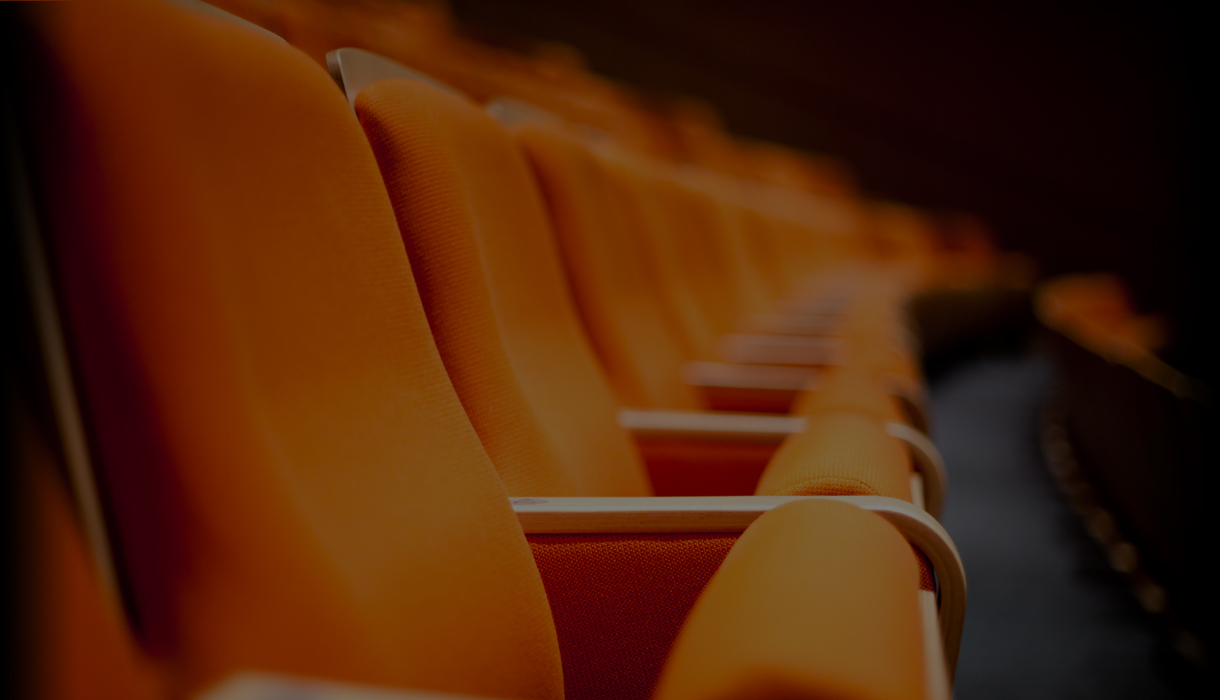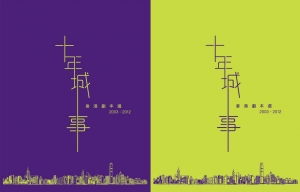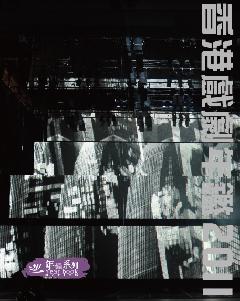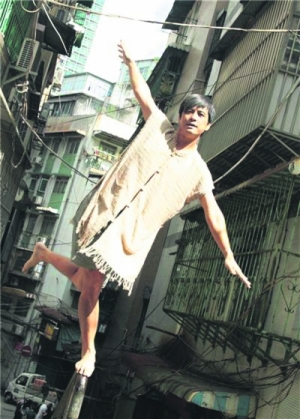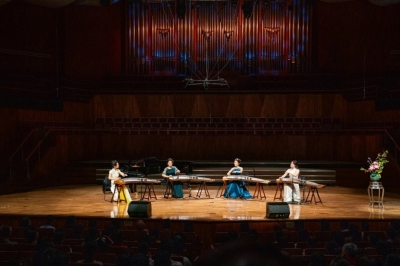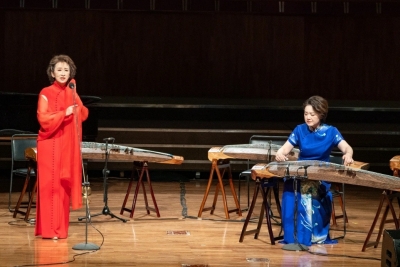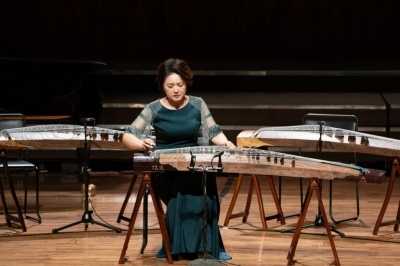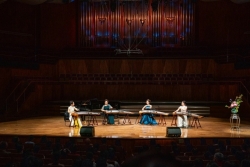 |
As stage lights dim and the zheng's strings resonate like a crystal stream, Kunqu opera's flowing sleeves intertwine with piano keys in a dance of shadows—the "Jasmine Fragrance: Aesthetic Assembly of Guzheng Music" (茉莉芬芳:古箏雅集) at Xinghai concert hall on July 5th weaves "auditory-visual enjoyment and the fusion of tradition and innovation" into a picture of ancient rhythms and contemporary artistry. From the symmetrical aesthetics of stage design to the layered resonance of instruments, and from traditional techniques to boundary-breaking compositions, every detail whispers reverence for cultural heritage while shouting boldness in artistic reinvention. This is not merely a concert, but a rebirth of traditional art in the modern context, where each note and gesture bridges millennia of musical wisdom with cutting-edge creativity.
Visual Elegance: Symmetry and Subversion in Aesthetic Narration
Visually, the stage unfolds as a study in balanced artistry. From a macroscopic perspective, the stage is symmetrical. When four guzheng players perform as an ensemble, their positions form an arc-shaped symmetry, with a harmonious visual proportion. When a guzheng player performs a solo, they are positioned at the center to highlight the main focus. On top of this overall balance, a piano is placed at the rear left of the stage, and a porcelain flowerpot is positioned at the front right. This kind of arrangement, which seemingly breaks the balance, adds richness and innovation to the visual effect, preventing the overall layout from appearing monotonous and dull, and it aligns with traditional Chinese aesthetics. The house lights dimmed as the performance commenced, with the stage lighting bright yet soft, allowing the focus to remain on the artistry itself.
Complementing this visual rhythm is the intentional gradation of performers’ costumes. In terms of the vividness of the colors and the complexity of the designs of the costumes, there is a decreasing trend from the Kunqu opera performer to the guzheng players and then to the pianist. The Kunqu opera performer wears bright red costumes, and long cloth pieces similar to water sleeves are attached to the arms to match the performer's opera movements. The guzheng players' costumes are full of ancient aesthetics and the colors are more subdued, featuring colors such as white, yellow, dark blue and green. Moreover, they changed into different costumes in the second half of the performance for visual variety. The piano player's costume is the most understated, wearing black suit, highlighting its supporting role in this concert.
Stage layout
(Photo: by Tammy,Xinghai Concert Hall)
But it is the performers’ movements that breathe life into these visuals, transforming arrangements and attires into a living narrative. Judging from the individual performances of each artist, they have all perfectly achieved both technical expression and emotional release. Professor Wanxia Deng, a Kunqu opera actress, carries the demeanor of a master. Although there was no change in position in her two pieces, her hand gestures and facial expressions are extremely engaging. Her sleeve-flicking and hand-waving actions sufficed to show her profound foundation in opera. As for the guzheng players, the right-hand and techniques of hooking, stroking, plucking, rolling, and arpeggio, and the left-hand techniques of pressing and rubbing, and even the calmness displayed when moving the bridge while tuning the strings, were all highly aesthetically pleasing. The movements of their upper bodies during the performance arealso elegant and charming. During the performance of Rushi (As Wish,《如是》), Peiwen Li, a guzheng player, seem to be performing a dance with her upper body. Her head rise and fall with the musical phrases. Her limbs gathered strength before the beginning of a phrase and trembled during the rests, like a well-tensioned bow. Her arms also form a circular-like trajectory during rapid plucking. At the end of a phrase, she raises her arms high and hold the pose for a long time before slowly lowering them, which is very eye-catching. Her body language breaks through the role of an "instrument operator", transforming the guzheng into an "active carrier" for cultural expression and subverting the inertial perception of "people serving skills" in traditional instrumental performances.
In the cooperation among different performers, since there were no rhythmic percussion instruments to regulate the tempo changes and many of the rests were free, their tacit understanding was also shown in every gesture. For example, before the start of the guzheng ensemble of Jiangjun Ling (General’s Command, 《將軍令》), one could clearly observe the "preparatory postures" of the performers. The guzheng players would use their peripheral vision to notice each other's intentions and thus accurately find the entry point. This unspoken synergy, woven through glances and subtle shifts, became the silent thread binding the visual tapestry of the performance. Yet as the eye drank in this harmony of movement, the ear was soon swept into an even richer symphony, where sound itself would take up the dialogue between tradition and innovation
Auditory Harmony: Rich and Full of layers in Sonic Poetry
If you were to describe the auditory experience in one sentence, it would be rich and full of layers. Throughout the entire concert, there were various performance styles, such as guzheng ensembles, guzheng solos, collaborations between guzheng and piano, and collaborations between Kunqu opera and the guzheng. In these different combinations, the differences in timbre between different instruments, the resonance of sounds during ensembles, the prominence of melodies in solos, and the interaction between vocals and stringed instruments all greatly enhanced the fun and novelty of the auditory experience.
In Gusu Cheng (The Gusu City,《姑蘇城》), numerous passages with unexpected emotional changes. Like after a slow and even somewhat sad passage, a very lively and cheerful segment suddenly is played. In such a guzheng performance, performers especially need to pay attention to the changes in the volume and dynamics. And with the emotions shift, there will also be great differences in the speed and rhythm of the sound. When the speed gradually increases or decreases and the volume gradually strengthens or weakens, this process occurs evenly and uniformly, ensuring a smooth and natural auditory transition.
In addition, in performances of guzheng ensemble like Yue’er Gao (Lunar Ascension, 《月兒高》), the arrangement of the sounds is diverse. There is one part that four-person unison playing, another part of different melodic lines by duo-duo formation, and also a part where three people accompany the main melody played by one principal performer. This transformation responds to the contemporary society's cultural emphasis on the "symbiosis of the individual and the collective." The modernization of traditional instruments, in essence, is a keen capture of the social mindset.
In the collaborations of different instruments, the sense of musical texture and richness of the sound are highlighted. When the piano and the guzheng are played in an ensemble, most of the time the guzheng serves as the main body of the melody, while the piano, as an auxiliary instrument, provides chordal support in the background. Therefore, the overall sound of the piano is softer, and it doesn't need a microphone for sound amplification like the guzheng. When the guzheng pauses for a moment, the piano will also fill the gap with a solo to boost the emotions. When the two instruments are played together, there are also many responses between musical phrases, full of interactivity.
Equally striking are the nuances of Kunqu vocal artistry on display. Professor Deng's pronunciation follows the system of traditional Chinese opera. Professor Deng’s delivery adheres strictly to traditional opera phonetics—note how "將" (jiāng) in the line "最難將息" softens into "ziang," a subtlety that anchors the performance in classical convention. Her timbre is soft, delicate, and her singing tone presents a silky and smooth texture. Moreover, her vocal techniques are diverse, complementing the instrumentation perfectly. For instance, in the song Sheng Sheng Man (Slow, Slow Tune, 《聲聲慢》), her voice suddenly swells following the sound of the guzheng and then suddenly stops. In the line "聽嚦嚦鶯聲溜的圓" (Listen, how the warbler's liquid trills rounding the air) from You Yuan (Wandering in the Garden, 《遊園》), when she sings the onomatopoeia "嚦嚦", she actually emits short, bird-like sounds following the staccato notes of the guzheng. These vocal flourishes, rooted in age-old operatic traditions, serve as a bridge to the deeper cultural legacy that pulses through every piece—for beyond the interplay of sound and voice lies a rich tapestry of heritage waiting to be unfurled.
Wanxia Deng is performing Kunqu Opera
(Photo: by Tammy,Xinghai Concert Hall)
Traditional Roots: Classical Instruments and Repertoires in Cultural Inheritance
The presentation of tradition in this concert is deeply rooted in the fertile soil of Chinese music. With the integration of zheng and classical art as the main thread, it interprets cultural inheritance. As an important background, the Zhe School guzheng pieces start with the ensemble performance of Jiangjun Ling (General’s Command, 《將軍令》). The performers use the unique pressing, sliding, plucking and striking techniques of the guzheng to restore the "simple and vigorous" style of Zhe School guzheng pieces. When the rhythm is strong, it is like a general brandishing a weapon and thousands of troops charging forward; when the melody winds, it is like military strategies with undercurrents surging. It reproduces the ancient military scenes in the form of sound and picture, inheriting the musical expression of historical narration in Zhe School guzheng pieces.
In Gaoshan Liushui (High Mountains and Flowing Water, 《高山流水》), the emphasis on "compensating for the sound with charm" is reflected in the smooth glides, tremolos and vibratos produced by pressing the strings, making the artistic conception of mountains and waters vivid and tangible. It is like a contemporary continuation of the story of Boya and Ziqi. Through the millennium-old inherited performance techniques and the connotation of the piece, it conveys the humanistic spirit of the ancients' affection for mountains and waters and the cherishing of bosom friends.
Jing Luo is playing Gaoshan Liushui
(Photo: by Tammy,Xinghai Concert Hall)
The integration of Kunqu Opera and the guzheng is an exquisite practice of mutual learning among traditional arts. In Sheng Sheng Man (Slow, Slow Tune, 《声声慢》), Deng's Kunqu singing strictly adheres to the rules of the gentle and flowing melody. The intonation of "寻寻觅觅,冷冷清清,凄凄惨惨戚戚" shows the elegance of Song Dynasty ci(宋詞) through the delicate handling of the beginning, middle and end of each character. Jing Luo's guzheng music serves as the "background of sound and picture". The gentle arpeggios simulate the continuous drizzle, and the low-pitched tremolos create a lonely atmosphere. The composer Xuehua Zhou uses the music as a bridge to make the charm of Song Dynasty ci, the Kunqu singing, and the timbre of the guzheng resonate, replicating the aesthetic paradigm of the integration of classical literature, traditional opera and instrumental music. Yet while such works honor the past with meticulous reverence, the concert’s true dynamism lies in how it does not merely preserve tradition—but reimagines it, letting age-old artistry bloom in bold new forms.
Innovative Soul: Cross-Border Breakthroughs in Artistic Reinvention
The concert breaks through with cross-border thinking and forms, injecting contemporary vitality into traditional music and broadening the boundaries of artistic expression. The clash and conversation between the zheng and the piano become an innovative highlight throughout the performance. In the piece Rushi (As Wish, 《如是》), Peiwen Li uses modern techniques such as "rapid finger sequences" on the zheng to show intense emotions. This time, Yuanqing Li's piano playing provides symphonic harmonies as a supportive backdrop. Danhong Wang's composition breaks the traditional structure and integrates Western musical forms, broadening the emotional expression of zheng music in the context of contemporary music. In addition, the innovative the ensemble arrangements endows zheng music with new auditory levels.
In the trio performance of Moli FenFang (Jasmine Flower,《茉莉芬芳》), the zheng players perform distinct voice parts. There are differences in melodic lines and pitch ranges during the performance. The high-pitched zheng outlines the lightness of jasmine flowers with bright melodies, the middle-pitched zheng fills in the layers with harmonies, and the low-pitched zheng provides a foundation with tremolo finger techniques. The cooperation of the three enriches the harmonic texture of the melody. It makes the ancient piece is no longer a "single-line inheritance" but adapts to the contemporary audiences' demand for rich auditory experiences through the ensemble performance form. It provides a stage practice that can be used for reference for the transformation of ethnic musical instruments from "traditional solo" to "modern concerto" and explores new possibilities for the expression of traditional music through cross-boundary integration.
The concert also made significant breakthroughs in musicality and carried out major attempts beyond traditional thinking. Take Gusu Cheng (The Gusu City,《姑蘇城》), which impressed me the most, as an example. The structure of this piece is clear. The three movements - "Canglang Ting (Canglang Pavilion, 滄浪亭)", "Shantang Jie (Shantang Street, 山塘街)" and "Dongfang Zhi Men (Oriental Gate, 東方之門)" - each have their own stylistic and emotional characteristics, offering a rich and varied listening experience. In the first half of the piece, the melodies of the guzheng and the piano are within the traditional pentatonic scale, sounding very harmonious, gentle and mellow. However, in the second half of the piece, the arrangement goes against the norm. The melodic lines break out of the pentatonic scope and are not even limited to the ordinary heptatonic scale. Many non - harmonious non - chord tones are added, and there are even cases of tonicization and modulation in the chord arrangement. This makes the originally predictable melodic lines angular, adding a touch of uncertainty and liveliness. This non - traditional composition and arrangement conform to the rules of modern pop music, making the whole song sound like a pop song with a complete structure and vivid melody. In addition, the performance techniques of the guzheng are also very innovative. At the climax of the piece, the performer Yangfei Zhou even simulated the performance form and timbre of percussion instruments by hitting the body and strings of the guzheng, broadening the performance form of stringed instruments and creating a refreshing experience for the audience.
However, the creativity in this piece leds me to think from another perspective: Will over-relying on non-chord tones to create a "sense of freshness" weaken the gentle and delicate characteristics unique to Suzhou culture? Is this a liberation of tradition or a compromise with contemporary aesthetics? Different audiences may have different answers. But artists still need to strike a balance. As far as I’m concerned, only by safeguarding that unique charm and character in the process of innovation can they demonstrate artistic consciousness.
This concert, with vision as its form and sound as its soul, charts a vivid trajectory of artistic inheritance at the intersection of tradition and innovation. As the last note fades, it leaves audiences not only with sensory awe, but also with a profound insight: for traditional music to transcend eras, it must sink roots deep in cultural soil while reaching for the sky of innovation. This concert is more than a performance—it is a manifesto, proving that only by honoring heritage and embracing boldness can ancient melodies compose timeless refrains in the tide of time.
本網站內一切內容之版權均屬國際演藝評論家協會(香港分會)及原作者所有,未經本會及/或原作者書面同意,不得轉載。
